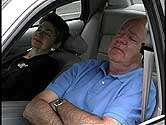Eye docs must do more to spot unsafe older drivers: study

(HealthDay)—Most eye doctors consider it their responsibility to ask older patients about driving problems, but this hit-or-miss approach may not be nearly enough to clear the roads of unsafe elderly drivers, new research suggests.
By 2020, as the U.S. population ages, the number of drivers over age 65 will reach 40 million, according to the study. Many will have failing vision, reduced mobility and perhaps cloudy thinking, thus posing a serious public health issue, the researchers said.
For two new studies, researchers surveyed more than 400 ophthalmologists and optometrists in Michigan with patients older than 65. The researchers asked the doctors for their views on whether to ask patients about driving, how to decide if a patient's vision is inadequate and whether they referred patients to primary care physicians.
"We were pleased to see a high response" of vision care providers who ask about driving, said David Musch, a professor of ophthalmology and visual sciences at the University of Michigan, and lead author and co-author of the studies.
The eye specialists, however, did not usually refer patients they were concerned about to primary care physicians, who are better equipped to assess thinking and physical ability and how they could affect safe driving, Musch said.
And providers rarely asked about common driving situations, such as making left turns, that might also reflect driving ability, the survey found.
Age-related changes in eyesight along with declines in mental and physical abilities can hamper driving ability. Some states, including Florida, Oregon and Virginia, require eye exams for older people who want to renew their driver's license. But they don't usually have criteria for other disabilities such as arthritis that could limit a driver's range of motion, for example.
Fifteen percent of all licensed U.S. drivers in 2007 were 65 and older, according to the National Highway Traffic Safety Administration. Automobile accidents are a leading cause of injury-related death in people aged 65 to 74.
The studies, published Oct. 8 in the journal Archives of Ophthalmology, found the following:
- In 87 percent of cases, participants said they would always or often inquire about driving ability if a patient did poorly on an eye exam. Other common reasons were if a patient or family member asked about a driving problem.
- Two thirds of survey respondents said they ask all older patients about driving ability.
- Although most said they always or often asked about night driving, glare and reading signs—common challenges for older drivers—less than 10 percent also asked about making left turns, merging and backing up, which are potential downfalls for poor-sighted drivers.
- Less than 30 percent of providers said they asked about driving after noticing a problem other than visual impairment.
More than half of the eye specialists said they were reluctant to report unsafe drivers to regulatory agencies, because this could undermine the doctor-patient relationship. Some also worried about liability issues.
The survey also revealed that only about 36 percent and 28 percent of vision care providers, respectively, referred their patients to primary care physicians or driving rehabilitation always, often or sometimes.
Communication between eye doctors and primary care doctors is essential in this process, Musch said.
In many cases, driving rehab can help older patients stay on the road longer, said Patrick Baker, a driver rehabilitation therapist at Cleveland Clinic. For example, driving specialists can add mirrors to the car of someone with limited neck rotation or talk with people with mild cognitive impairment and their caregivers about avoiding traffic and night driving .
Dr. Barbara Messinger-Rapport, director of the Center for Geriatric Medicine at Cleveland Clinic, believes eye care providers have a duty to put the brakes on drivers with visual impairment.
They "should ask each patient over the age of 75 if they're driving, and if their visual acuity and peripheral vision [the two legally required tests] are not within the licensing requirements for their state, they should inform the patient," she said.
How providers assess vision in the first place may also need improvement. Nearly all providers test visual acuity, in which patients read smaller and smaller letters, and peripheral vision, but there is not strong evidence for how these tests relate to safe driving, Musch said.
Tests like contrast sensitivity could improve the assessment of safe driving, some say. The contrast test is similar to the visual acuity test except patients have to read letters that are gray, instead of black, on a white background.
Baker said he wishes doctors would test contrast sensitivity more often.
"You don't need to be able to read the license plate in front of you, you need to be able to tell if it's a car in front of you or a shadow or some other object," he said.
More information: To learn more about driving safety, visit the U.S. National Highway Traffic Safety Administration.
Copyright © 2012 HealthDay. All rights reserved.













